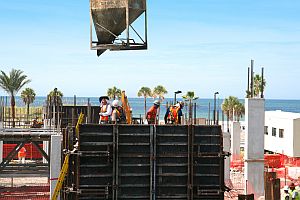Health and Safety Tips for Construction Workers
 According to the Occupational Safety and Health Administration (OSHA), there were 721 fatal accidents on construction sites in 2011, accounting for 17.5% of all worker fatalities that year. The leading causes of death to workers on construction sites were falls, electrocution, being struck by an object and becoming trapped. OSHA estimates that by eliminating these four primary causes, approximately 400 lives would be saved every year. And it’s not just worksite accidents that can be dangerous to construction workers’ health-bad ergonomics and exposure to toxic materials can also pose risks. Following are some health tips for construction workers to help avoid these hazards.
According to the Occupational Safety and Health Administration (OSHA), there were 721 fatal accidents on construction sites in 2011, accounting for 17.5% of all worker fatalities that year. The leading causes of death to workers on construction sites were falls, electrocution, being struck by an object and becoming trapped. OSHA estimates that by eliminating these four primary causes, approximately 400 lives would be saved every year. And it’s not just worksite accidents that can be dangerous to construction workers’ health-bad ergonomics and exposure to toxic materials can also pose risks. Following are some health tips for construction workers to help avoid these hazards.
To reduce falls from scaffolds, ladders and roofs:
* Be sure you are trained in the proper use of all equipment and ensure that equipment is thoroughly inspected before each shift.
* Check that the weight placed on ladders and scaffolding does not exceed the recommended limits.
* Do not step or sit on a skylight if you are working on a roof, as there is a chance that it may not bear your weight.
* Check for unsecure shingles or roof tiles that can cause you to lose your footing.
* Placing safety netting below any roof openings can save someone’s life in the event of a fall.
To avoid electrocution:
* Be sure to turn off the power before working on any electrical equipment.
* Wear insulated rubber gloves and boots when working in wet or damp conditions.
* All electrical cords should have grounding plugs and any frayed cords should be replaced.
* Ensure that equipment such as ladders and scaffolds never come within 10 feet of electrical power lines.
To avoid toxic materials:
* Wear protective equipment when working on sites that may contain lead paint. Bridges, tunnels and elevated highways were all commonly painted with lead-based materials. Have your blood tested periodically to ensure that levels of lead in your blood are within normal range.
* Wear a face mask to keep from breathing in toxic fumes when working with tar or asphalt to reduce skin, eye and respiratory irritation.
* When working around stonecutting, paint, lacquer or asbestos you should wear a respirator.
To avoid ergonomic injuries:
* When lifting, be sure to bend your knees and keep your hips and shoulders aligned. Do not round your back or twist when lifting, as it may cause a back injury.
* Make sure your tool belt is balanced. Extra weight on one side of the belt can pull your body out of alignment, increasing the risk of injury.
* Sit on a sturdy stool when working at lower levels rather than kneeling or squatting.
* Choose ergonomic tools that are light and properly balanced
* Keep your wrists in a neutral position when working rather than having them flexed forward or backward. This will help prevent carpal tunnel syndrome.